Nice Carnival: Ultimate Guide to Dates, Events & Must-See Parades
Advertisements
Excited about Nice Carnival, one of the world’s most vibrant festivals? Discover everything about this spectacular event in the French Riviera—parades of dazzling floats, colorful flower battles, electrifying street performances, and the famous Battle of Flowers. Get insider tips on dates, tickets, best viewing spots, and must-see highlights for an unforgettable experience at Nice Carnival!
Table of Contents
Introduction to Nice Carnival
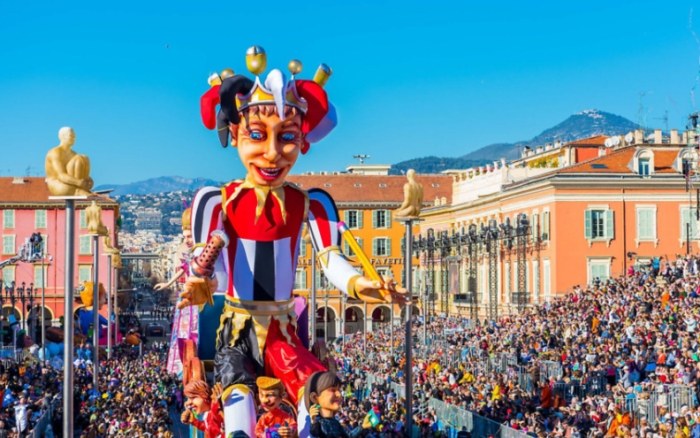
What is Nice Carnival?
Nice Carnival, or Carnaval de Nice, is one of France's most vibrant and renowned cultural festivals. Held annually in the picturesque city of Nice on the French Riviera, it is a celebration marked by extravagant parades, colorful costumes, music, dancing, and a festive atmosphere that captivates both locals and tourists alike. Known for its grandeur and creativity, Nice Carnival has earned its place among the world's top carnival celebrations, alongside iconic events like Rio de Janeiro's Carnival and Venice's Carnival.
Historical Background
The origins of Nice Carnival can be traced back to the Middle Ages, making it one of the oldest carnival celebrations in Europe. Initially, it was a pagan festival associated with the end of winter and the arrival of spring, symbolizing renewal and fertility. Over the centuries, the festival evolved, incorporating Christian traditions, particularly the pre-Lenten period leading up to Ash Wednesday. During this time, people indulged in feasting and merriment before the solemn period of Lent began.
In the 19th century, Nice Carnival gained international recognition, attracting visitors from across Europe and beyond. The city's strategic location on the Mediterranean coast, combined with its mild climate, made it an ideal destination for winter tourism. The carnival became a showcase of Nice's cultural heritage, with parades, floats, and costumes reflecting the region's rich history and artistic influences.
Traditional Customs and Symbols
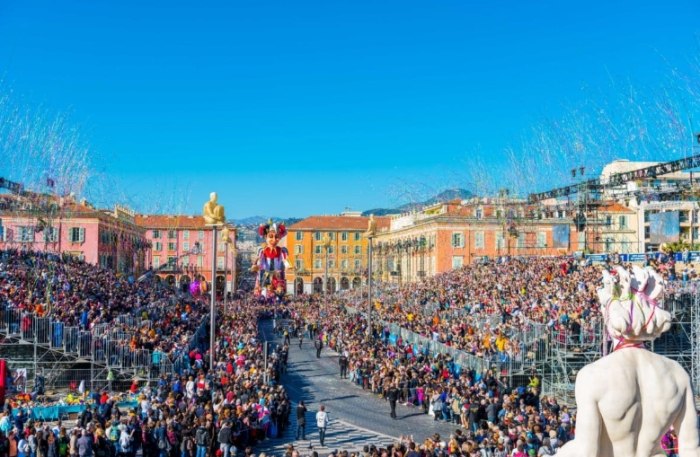
Key Elements of Nice Carnival
- Flower Battles: One of the most unique traditions of Nice Carnival is the Bataille de Fleurs (Flower Battle). During this event, floats decorated with thousands of fresh flowers parade through the streets, and participants toss flowers to the crowd. The Flower Battle symbolizes the arrival of spring and the abundance of nature.
- King of the Carnival: Each year, a symbolic Roi du Carnaval (King of the Carnival) is chosen to preside over the festivities. The King is often depicted as a whimsical character, such as a giant puppet or a historical figure, and is paraded through the city before being "burned" at the end of the carnival, symbolizing the end of winter and the beginning of spring.
- Masks and Costumes: Participants in Nice Carnival wear elaborate masks and costumes, often inspired by themes such as history, mythology, or current events. Masks serve as a way to conceal identities and encourage freedom of expression during the festival.
Symbolism in Nice Carnival
- Spring and Renewal: The carnival's emphasis on flowers, music, and festivity reflects the theme of spring and renewal. It is a time to celebrate life, love, and the beauty of nature.
- Community and Togetherness: Nice Carnival brings the community together, fostering a sense of unity and shared joy. It is a time for people of all ages and backgrounds to come together and celebrate.
- Art and Creativity: The festival is a showcase of artistic creativity, with floats, costumes, and performances often pushing the boundaries of imagination. It encourages participants to express themselves through art and performance.
Celebration Activities
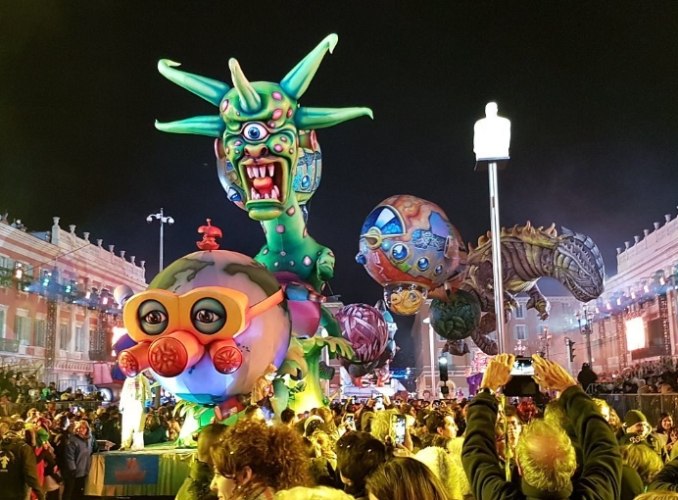
Pre-Carnival Preparations
- Float Building: Months before the carnival begins, artists and craftsmen work tirelessly to build elaborate floats for the parades. These floats are often sponsored by local businesses or organizations and are designed to reflect the year's theme.
- Costume Design: Participants also begin designing and creating their costumes, often incorporating traditional elements with modern twists. Costume contests are held throughout the carnival, rewarding the most creative and elaborate designs.
- Promotional Events: To build excitement, the city organizes promotional events, such as press conferences, costume reveals, and preview parades, giving locals and tourists a taste of what's to come.
Main Carnival Events
- Opening Parade: The carnival officially kicks off with a grand opening parade, featuring floats, marching bands, dancers, and the King of the Carnival. The parade winds through the city's main streets, drawing large crowds of spectators.
- Flower Battles: As mentioned earlier, the Flower Battles are a highlight of the carnival. These events take place on specific days and are a spectacle of color and fragrance as floats shower the crowd with flowers.
- Night Parades: In addition to daytime parades, Nice Carnival also features night parades, where floats and costumes are illuminated with lights, creating a magical atmosphere. These parades often include fireworks and live music.
- Children's Carnival: A dedicated children's carnival is held, featuring smaller parades, games, and activities tailored for younger audiences. It is a family-friendly event that ensures children can also enjoy the festivities.
Closing Ceremony
- Burning of the King: The carnival concludes with the Burning of the King, a symbolic event where the King of the Carnival is set ablaze, signaling the end of winter and the beginning of spring. This event is often accompanied by fireworks and a final parade.
- Farewell Parade: A farewell parade marks the official end of the carnival, with participants bidding farewell to the festival and looking forward to the next year's celebration.
Modern Evolution of Nice Carnival
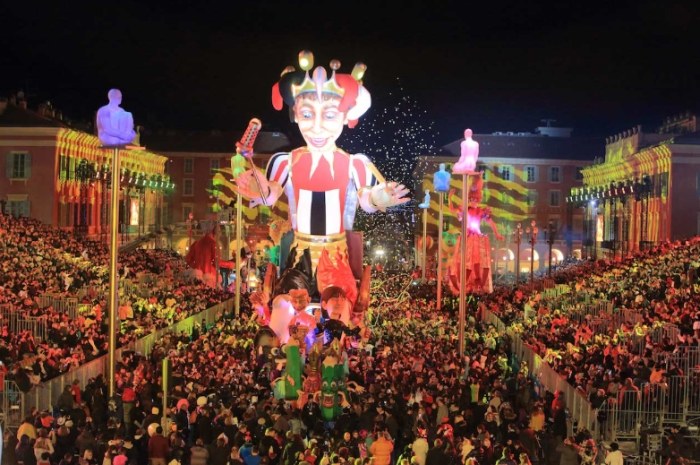
Incorporation of Technology
In recent years, Nice Carnival has embraced technology to enhance the festival experience. LED lights, projections, and interactive elements have been incorporated into floats and costumes, creating a more immersive and dynamic atmosphere. Social media has also played a significant role in promoting the carnival, allowing people from around the world to follow the festivities in real-time.
Diversity and Inclusivity
Nice Carnival has become more diverse and inclusive over the years, reflecting the city's multicultural population. Parades and events now feature a wider range of themes, costumes, and performances, celebrating different cultures and traditions. This inclusivity has made the carnival more appealing to a broader audience, fostering a sense of unity and understanding.
Sustainability Initiatives
In response to growing environmental concerns, Nice Carnival has implemented sustainability initiatives. Floats are now designed to be more eco-friendly, using recyclable materials and reducing waste. The Flower Battles also prioritize the use of locally sourced and sustainable flowers, minimizing the event's carbon footprint.
Classic Carnival Flow
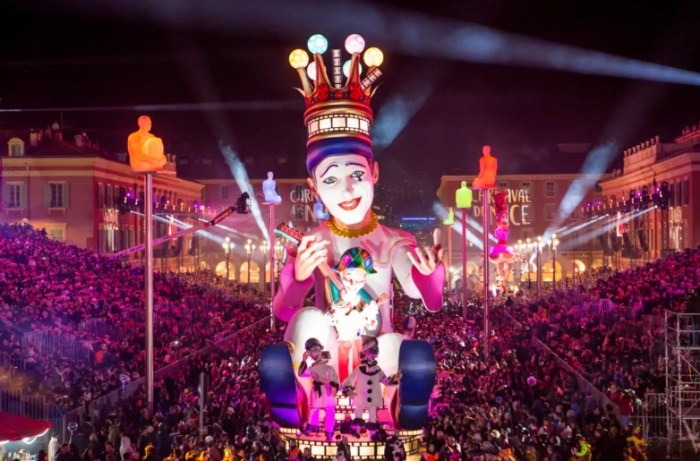
Week 1: Pre-Carnival Build-Up
- Monday: Opening ceremony with the announcement of the year's theme and the introduction of the King of the Carnival.
- Tuesday-Thursday: Costume contests, float previews, and promotional events.
- Friday: First parade, featuring floats and performers getting the city into the carnival spirit.
Week 2: Main Carnival Week
- Monday-Wednesday: Daily parades, including the Flower Battles, with floats and costumes showcasing the year's theme.
- Thursday: Children's Carnival day, with parades and activities tailored for children.
- Friday: Night parade, featuring illuminated floats and live music.
- Saturday: Grand parade, the highlight of the carnival, with the most elaborate floats and performances.
Week 3: Closing Week
- Monday-Wednesday: Continued parades and events, with a focus on community involvement and participation.
- Thursday: Final Flower Battle, a grand finale of the flower-throwing tradition.
- Friday: Burning of the King ceremony, marking the end of the carnival.
- Saturday: Farewell parade, bidding farewell to the festival and looking forward to the next year.
Practical Information for Visitors
Dates and Duration
Nice Carnival typically takes place in February, lasting for two to three weeks. The exact dates vary each year, so it is essential to check the official carnival website for the most up-to-date information.
Tickets and Access
- Parade Tickets: Some parades, particularly the grand opening and closing parades, may require tickets. These can be purchased in advance through the official carnival website or at ticket booths in the city.
- Free Events: Many carnival events, including the Flower Battles and some parades, are free to attend. However, it is advisable to arrive early to secure a good viewing spot.
- VIP Packages: For a more exclusive experience, VIP packages are available, offering access to reserved seating, backstage tours, and other perks.
Accommodation and Transportation
- Accommodation: Nice is a popular tourist destination, so it is advisable to book accommodation well in advance, especially during carnival time. Hotels, guesthouses, and vacation rentals are available throughout the city.
- Transportation: Nice has an efficient public transportation system, including buses, trams, and trains. During the carnival, additional shuttle services may be provided to transport visitors to and from parade routes.
Safety and Etiquette
- Safety: As with any large event, it is important to stay aware of your surroundings and follow any safety instructions provided by event organizers. Keep an eye on personal belongings and avoid crowded areas if possible.
- Etiquette: Be respectful of other participants and spectators. Follow the rules of the carnival, such as not touching floats or costumes without permission, and dispose of waste properly.
Q&A
1. What is a Nice Carnival in France?
Nice Carnival, or Carnaval de Nice, is an annual festival held in Nice, France, known for its extravagant parades, colorful costumes, music, dancing, and festive atmosphere. It is one of the oldest and most renowned carnival celebrations in Europe, dating back to the Middle Ages. The carnival typically takes place in February and lasts for two to three weeks, featuring events such as the Flower Battles, night parades, and the burning of the King of the Carnival.
2. What is the best Carnival in France?
While Nice Carnival is widely regarded as one of the best carnivals in France, other notable carnival celebrations include:
| Carnival Name | Location | Key Features |
|---|---|---|
| Dunkirk Carnival | Dunkirk | Wild street parties, costumes, and music |
| Limoux Carnival | Limoux | Longest-running carnival in France |
| Mulhouse Carnival | Mulhouse | Themed parades, floats, and fireworks |
Each carnival has its unique charm and traditions, making it difficult to declare one as the "best." However, Nice Carnival's grandeur, international recognition, and picturesque setting on the French Riviera make it a top choice for many visitors.
3. Is the Nice Carnival free?
Many events at Nice Carnival, including the Flower Battles and some parades, are free to attend. However, certain events, such as the grand opening and closing parades, may require tickets. Additionally, VIP packages offering exclusive access and perks are available for purchase. It is advisable to check the official carnival website for information on ticketed events and pricing.
4. What is the famous Carnival in France?
Nice Carnival is undoubtedly one of the most famous carnivals in France, known for its extravagant floats, colorful costumes, and lively atmosphere. Other well-known carnivals include Dunkirk Carnival, famous for its wild street parties, and Limoux Carnival, recognized as the longest-running carnival in France. Each carnival offers a unique experience, reflecting the cultural diversity and rich traditions of France.
Advertisements